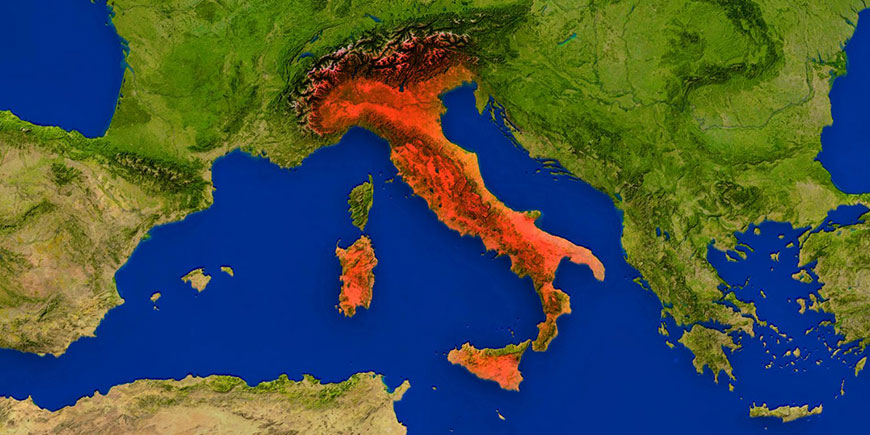Italy gets warmer: Highest daily minimum temperatures ever recorded, +1.20°C above historical average
In 2023, Italy recorded the highest daily minimum temperatures ever, an increase of +1,20°C compared to the historical average.
This is according to the report ‘Climate in Italy in 2023’ by the National System for Environmental Protection (SNPA), which provides an overview of the country’s climate conditions throughout the year..
What the latest climate report says about Italy
Daily minimum temperatures in Italy have never been so high: +1.20°C was the anomaly recorded in 2023, the highest in the historical series. The year 2023 was the second warmest year ever recorded, with an anomaly of +1.14°C compared to the climatological value for the period 1991-2020. This puts it just behind 2022, which holds the record with an anomaly of +1.23°C. This is the tenth year in a row that average annual temperatures have been above average. This shows a worrying trend of continued warming.
Of particular note was the month of October, which recorded an anomaly of +3.27°C above the climatological value, the highest in its monthly series since 1961. In July and September, significant anomalies above +2 °C were also recorded.
In addition, Sardinia’s absolute heat record was broken in July, with a maximum temperature of 48.2°C recorded in Jerzu and Lotzorai, in south-eastern Sardinia, giving us an idea of the intensity of the heat waves that hit the country.
The impact on our seas
The marine waters around Italy are not exempt from these changes. They are constantly warming. The surface temperature of the Italian seas in 2023 ranks second in the historical series, with an anomaly of +0.9°C compared to the 1991-2020 climatological average.
This phenomenon has a significant impact on marine ecosystems and marine related economic activities such as fishing and tourism.

Precipitation
After the severe deficit in 2022 (-22%), the cumulative annual precipitation in Italy in 2023 is almost average at -4% compared to the period 1991-2020. With a prevalence of negative monthly anomalies throughout the year, persisting from July to December in the South and Islands, the driest months were February (-56%) and September (-51%), while the rainiest months were May (+143%) and June (+77%).
The floods in central Italy were particularly devastating. During the month of May, the central-eastern areas of Emilia-Romagna were affected by two rainfall events in rapid succession, both of exceptional intensity, with cumulative rainfall for the first 17 days of the month reaching 609.8 mm at Trebbio (Modigliana, Lamone basin) and 563.4 mm at Le Taverne (Fontanelice, Santerno basin). The events resulted in 17 deaths, exceptional flooding, thousands of landslides and extensive and severe damage throughout the territory.
On 2 November, heavy thunderstorms caused exceptional rainfall in Tuscany, with maximum rainfall totals of 180-200 mm in 3 hours in the northern areas of the provinces of Pisa and Livorno, and 130-170 mm in 5-6 hours in the southern areas of the provinces of Pistoia and Prato. The impact on the ground was catastrophic, with flooding affecting major commercial areas and many residential neighbourhoods, and causing eight deaths.
The exceptional rainfall in Emilia-Romagna and Tuscany, as well as the particularly low rainfall in Sicily and parts of Ionian Calabria, are emblematic of an extreme Mediterranean climate.
Drought
Drought and related water scarcity problems continued to affect Italy in 2023. However, the severity of the situation differed from the critical situation in 2022. In fact, after the historical minimum of water resources recorded in 2022, i.e. 67 billion cubic metres – about half the average of the 30-year climatological period 1991-2020 – the availability of natural water resources in our country will recover in 2023, estimated at 112.4 billion cubic metres. However, with water availability 16% lower than the 1991-2020 average, Italy will still be experiencing drought and water scarcity in 2023.
In particular, the northern and central areas of Italy were characterised by severe and extreme drought in the first four months of the year, which subsided in the course of the year. During the last three months of the year, which are generally the wettest, there was a significant rainfall deficit, particularly in Sicily and parts of Ionian Calabria, leading to extreme drought conditions. Sardinia is also one of the areas where water availability appears to be particularly low.
Reducing emissions
The SNPA report stresses the urgency of addressing climate change through effective policies and concrete actions to reduce greenhouse gas emissions. The series of years with positive temperature anomalies is a clear signal of ongoing climate change, requiring global efforts to mitigate its effects and adapt to new climatic conditions.


